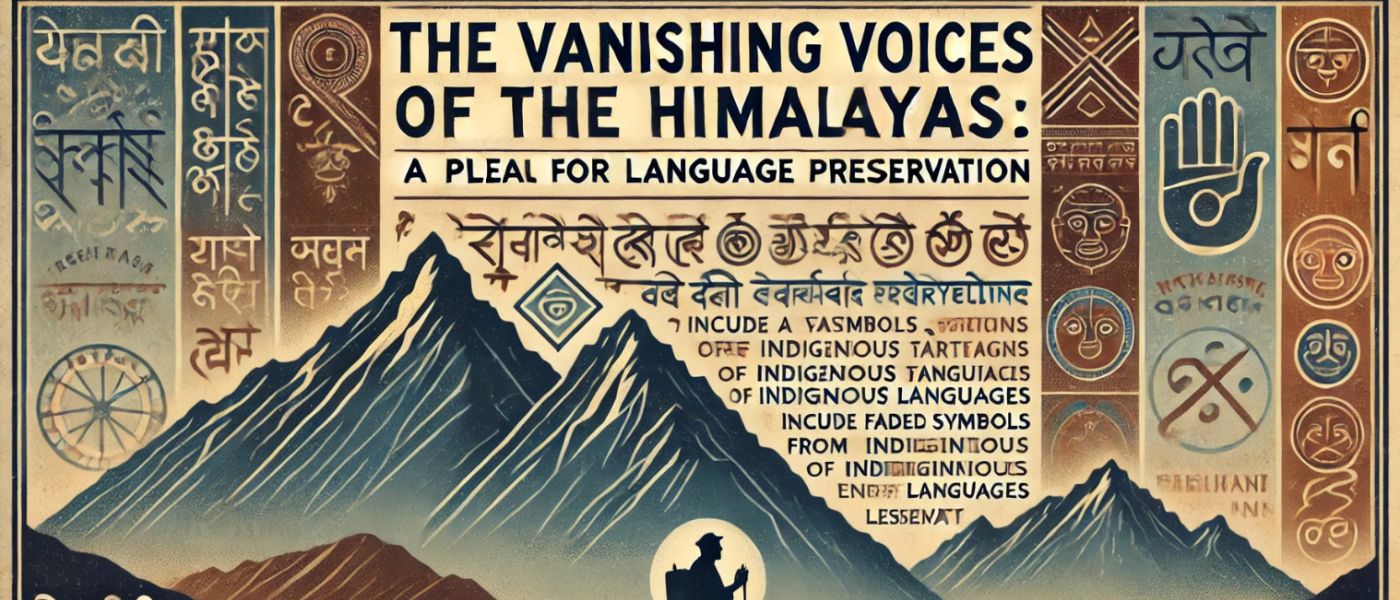A year ago, while watching Dave Chappelle accept the Mark Twain Prize, I was struck by his moving reflection on the Griot, a figure central to West African oral tradition. Known as storytellers, musicians, and keepers of history, Griots are, in essence, cultural repositories, preserving myth, genealogy, and wisdom for future generations. Chappelle, with his characteristic insight, compared the loss of a Griot to the burning of a library. He said, “Everyone would tell a Griot the stories, and they would remember them all so that they could tell future generations. When they got old, they’d tell them to someone else. In Africa, when a Griot dies, it’s like a library was burned down.” This reminded me of the Tamba among the Tamang people or shamans who similarly carry ancestral knowledge and cultural memory, binding communities to their mythic past and cosmologies.
As each speaker of an indigenous language fades, entire systems of belief, cultural practices, and ancestral philosophies gradually move towards the brink of extinction. In an era increasingly shaped by Artificial Intelligence and the omnipresence of digital technologies, the ancient oral tradition and cultural connections face imminent erasure. With English treasured as a global lingua franca and Nepali as the primary language of national communication, native languages are worryingly marginalized. As more students flock to IELTS and PTE classes, the indigenous languages, once the conduits of collective memory, worldviews, and philosophies, now confront a profound crisis. This cultural amnesia signals the gradual erosion of identities and lifestyle intricately tied to language.

Languages are vanishing at an alarming rate. It is the loss or eradication of centuries of culture, identity, and accumulated wisdom, a wide spectrum of human experience, that cannot be replaced. According to UNESCO’s Atlas of the World’s Languages in Danger, 576 languages are critically endangered, with thousands more at risk.
For many people, the loss of a language might seem like a natural part of an ever-changing world, an inevitable consequence of more dominant languages taking over. But this perspective overlooks something deeply significant. Language isn’t only meant for communication. It’s the thread that connects people to their ancestors, their customs, and the land they call home. When a language fades away, is it simply a shift in vocabulary or is it the loss of shared spirit, a unique identity, and the centuries-old stories that form the essence of a group or community?
Take the Sherpa language, for example. It’s intimately woven into the very fabric of the Himalayas. This language contains words that describe the vast mountain landscapes in ways no other tongue can. From the towering snow-covered ridges to the lush, hidden valleys, the Sherpa people understand the land at a level that is beyond the surface. Their language reflects this deep, unbreakable bond. Similarly, the languages of the Magar and Gurung people carry within them stories, spiritual beliefs, and concepts that link these communities to the land. In this way, language becomes a sacred vessel, holding the philosophies, myths, and rituals that have shaped these cultures for millennia. Through their words, the people of the Himalayas have preserved the very essence of their worldview.
UNESCO’s Atlas of the World’s Languages identifies 73 indigenous languages of the Himalayas as critically endangered. Among these vulnerable tongues are Athpariya with 5,878 speakers, Bahing with 6,547, Baaramu with 8,140, and Belhariya with a mere 599. Other languages facing a precarious future include Bodo-Mech (4,375 speakers), Bote-Majhi (8,766), Byangsi (480), and Chantyal (4,283). Even smaller communities such as Kagate with only 99 speakers, Kaike with 50, Kharia with 238, and Kudmali with 227 face inevitable extinction. Other endangered languages include Dura (2,156 speakers), Jerung (1,763), Lhomi (808), Lohrung (3,716), and Raute (391). Each of these languages represents a rich yet fragile cultural heritage on the verge of vanishing.

What most people don’t realize is that language holds a wealth of knowledge about the natural world. It carries insights that can’t be found in textbooks or research papers. The Khambu Rai language, for instance, has words for medicinal plants and herbs that only grow in their mountainous environment. These plants form the foundation of the Rai people’s traditional healing practices, knowledge that has been passed down through generations of shamans and healers. Similarly, the Limbu language contains intricate details about seasonal cycles, agricultural practices, and the ever-changing landscape of the Himalayas. This wisdom has been honed over thousands of years and is inextricably tied to the survival of these communities.
Beyond practical knowledge, these languages also carry exceptional ways of thinking. Take the Magar or Tamang languages, which possess complex systems of tense and relational markers. These structures provide a nuanced understanding of time, space, and human relationships. They shape how speakers experience the world and navigate their lives. In these languages, the words encode emotions, social bonds, and even spiritual beliefs in ways that global languages like Nepali or English simply cannot.
Despite efforts by social organizations and cultural groups to protect these languages, progress remains limited. Few language classes attract more than a handful of students, and the publication of dictionaries hasn’t translated into a comprehensive preservation strategy. While these efforts offer a glimmer of hope, they fall short of the coordinated action needed to secure the future of these endangered languages. Granted, dictionaries are valuable for preserving vocabulary, but they can’t fully capture the depth and richness of a language.
The languages of the Himalayas are deeply embedded in oral traditions, their stories, songs, rituals, and myths passed down through generations by word of mouth. These oral traditions hold vast amounts of knowledge about spiritual beliefs, historical events, and the environment. They simply cannot be captured in writing. Though some of this knowledge can be recorded, much of it lives in the spoken word, the tone, the rhythm, the pauses, the expressions, that simply cannot be transcribed into dictionaries. Furthermore, many of these languages lack a formal written script, and even where a script exists, it is often unfamiliar or inaccessible to younger generations.
In 2005, the National Foundation for Development of Indigenous Nationalities (NFDIN) organized a seminar in Kathmandu to address the preservation and promotion of Nepal’s indigenous languages. Three key research papers presented during the event highlighted various strategies for language revitalization.
First, Yadava and Turin (2005) examined the linguistic landscape of Nepal, advocating for campaigns to raise the prestige of endangered indigenous languages by promoting their inclusion in education and literacy programs. Watters and Rai (2005) focused on mother-tongue education, asserting its importance as both a fundamental right and a means for deeper societal participation, which resonates with Rice’s (2018) perspective on language vitality. Finally, Watters and Tuladhar (2005) outlined a framework to foster coordination among national and international agencies, emphasizing collaborative efforts to support language preservation initiatives.
The preservation of Himalayan languages requires a calls for an active, community-centered approach to keep these languages alive. This involves integrating these languages into daily life through teaching, community engagement, and, crucially, preserving the oral traditions that carry cultural meaning. Documenting songs, stories, and rituals captures the language within its rich cultural framework, ensuring that its essence is preserved alongside the words. Community-driven language schools and cultural programs should be supported to teach these languages to younger generations, incorporating storytelling, customs, and practices that are inseparable from the language itself.

In today’s digital age, technology offers powerful tools to support this mission. Creating digital platforms, mobile apps, and audio and video resources could enable speakers and learners to interact with these languages in accessible and engaging ways, helping to build cultural pride and connection. However, true preservation also hinges on government and institutional support. National and local governments must recognize the urgency of this situation and commit to backing these efforts, from integrating language education into school curricula to funding cultural initiatives. A holistic preservation strategy requires this crucial institutional support, making language preservation a shared responsibility and a continued commitment.
As the world changes and the forces of globalization continue to shape the future, language preservation is an act of resilience, a commitment to justice across generations, and a defense of our collective intellectual heritage. The languages of the Himalayas, and of indigenous cultures everywhere, must be kept alive, intertwined with the lives of those who speak them, not just preserved in books or recordings. The loss of a language is the loss of a soul. So, as Dave Chappelle would put it, let us rise to protect these “libraries” before they’re lost forever.





Informative .